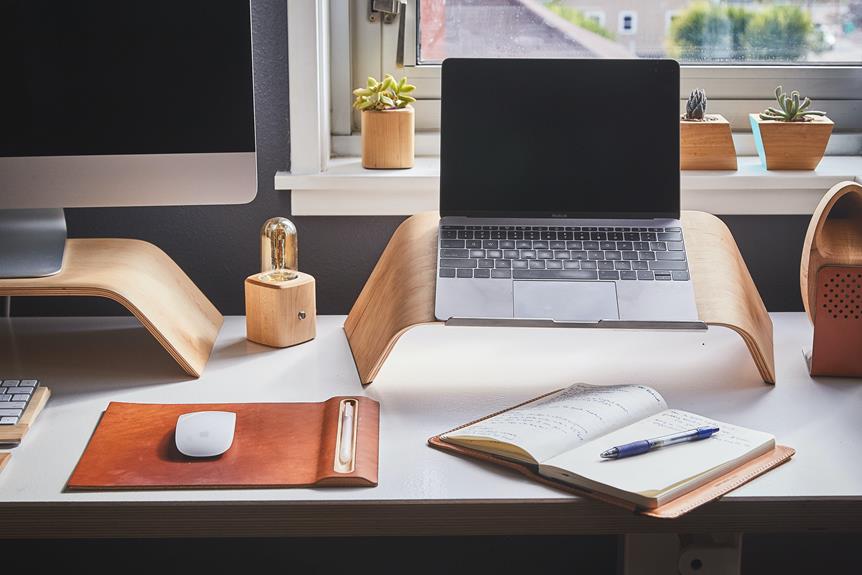You know the saying, 'Good fences make good neighbors'? Well, the same goes for your home office. Establishing healthy boundaries in your workspace is essential for maintaining productivity and balance.
Whether you're juggling household responsibilities, family dynamics, or simply trying to focus in a shared living space, creating clear boundaries is crucial. But how exactly can you achieve this in a way that works for everyone?
Let's explore some practical strategies to help you navigate the complexities of working from home while maintaining a healthy and harmonious environment.
Key Takeaways
- Create a designated workspace separate from living areas to mentally transition into work mode and separate work life from personal life.
- Manage time effectively by creating a to-do list, prioritizing tasks, setting boundaries around work hours, and disconnecting from work after hours.
- Create a distraction-free environment by decluttering the workspace, minimizing environmental triggers, and investing in ergonomic furniture.
- Establish boundaries with family members by discussing work-focused times, clearly outlining designated workspace areas, emphasizing the importance of respecting boundaries, and involving family members in the decision-making process.
Setting Physical Boundaries
When setting physical boundaries in your home office, it's essential to create a designated workspace that's separate from your living areas. Your personal workspace should be distinct and separate from your everyday living space. This clear demarcation will help you mentally transition into work mode when you enter your workspace and then switch off from work when you leave it. Whether it's a separate room, a specific corner of a room, or a well-defined desk, having a designated area solely for work can significantly improve your productivity and focus.
Having a personal workspace also helps in establishing a boundary between your work life and personal life. When you step into your workspace, you're signaling to yourself that it's time to focus and be productive. Similarly, when you step out of that space, you're creating a boundary to signify the end of the workday and the beginning of your personal time. This separation is crucial for maintaining a healthy work-life balance, especially when working from home.
Additionally, a designated workspace creates a professional environment, even within your home. It communicates to others in your household that when you're in that space, you're working and shouldn't be disturbed unless absolutely necessary. This clear boundary can help reduce interruptions and distractions, allowing you to work more efficiently.
Therefore, it's important to set physical boundaries to create a personal workspace that promotes productivity and work-life balance.
Establishing Time Management Techniques
After you've designated a specific workspace, it's essential to establish effective time management techniques to maximize your productivity and maintain a healthy work-life balance. Task scheduling is a crucial aspect of managing your time efficiently. Start your day by creating a to-do list, prioritizing tasks, and estimating the time required for each. This will help you stay organized and focused throughout the day. Consider using digital tools or apps to help with task scheduling and time tracking, as they can provide valuable insights into how you're spending your time and where you can make improvements.
When it comes to work-life balance, setting boundaries around your work hours is essential. Determine your core working hours and communicate them to your family or housemates. Let them know that during these hours, you need to be focused on work and shouldn't be disturbed unless it's an emergency.
Similarly, once your work hours are over, make a conscious effort to disconnect from work and engage in activities that help you unwind and recharge. This separation between work and personal time is crucial for maintaining a healthy balance and preventing burnout.
Implementing Distraction-Free Spaces
To create a distraction-free space in your home office, designate a specific area free from clutter and unrelated items. Creating designated zones within your home office for specific activities can help minimize environmental triggers that lead to distractions.
Here's how to implement distraction-free spaces effectively:
- Clear the Clutter: Start by decluttering the designated area. Remove any items that aren't essential to the specific task at hand. Keep only the tools and materials you need within arm's reach to minimize the temptation to get sidetracked.
- Establish Boundaries: Physically separate the distraction-free space from other areas of your home office. This could be as simple as using a room divider, bookshelf, or a strategically placed desk to create a clear boundary. This separation signals to your brain that when you're in this space, it's time to focus.
- Minimize Environmental Triggers: Pay attention to environmental factors that can cause distractions, such as noise, visual clutter, or uncomfortable seating. Consider using noise-canceling headphones, organizing cables and wires, and investing in ergonomic furniture to create a comfortable and conducive work environment.
Communicating Boundaries With Family Members
As you establish distraction-free spaces in your home office, it's important to effectively communicate boundaries with your family members to ensure a conducive work environment. Clear expectations and open communication are essential in this process.
Sit down with your family and discuss the specific times when you need to focus on work without interruptions. Clearly outline the areas in the house that are designated as your workspace and communicate the significance of respecting this boundary.
Mutual respect is a key component when communicating boundaries with family members. It's important to express how their support in honoring these boundaries will contribute to your productivity and overall well-being. Encourage an open dialogue where family members can express their thoughts and needs as well. This allows for a better understanding of each other's perspectives and helps in finding a compromise that works for everyone.
Additionally, involving your family in creating these boundaries can foster a sense of ownership and understanding. When they're part of the decision-making process, they're more likely to respect the established boundaries.
Prioritizing Self-Care and Well-Being
When working from a home office, taking care of your well-being should be a top priority to maintain a healthy work-life balance. Prioritizing self-care and well-being is crucial for your overall productivity and happiness. Here are three essential practices to help you achieve this:
- Stress Management: Working from home can sometimes blur the lines between work and personal life, leading to increased stress levels. It's important to develop effective stress management techniques, such as mindfulness meditation, deep breathing exercises, or taking short breaks to stretch and relax. Setting boundaries around your work hours and creating a designated workspace can also help alleviate work-related stress and prevent it from spilling over into your personal time.
- Work-Life Balance: Establishing a clear separation between work and personal life is vital for maintaining a healthy balance. Set specific work hours and stick to them as much as possible. After work hours, make it a point to engage in activities that you enjoy and that help you unwind. This could include physical exercise, hobbies, spending time with loved ones, or simply taking quiet moments for yourself.
- Mental Health and Self-Care Practices: Pay attention to your mental health by incorporating self-care practices into your daily routine. This could involve getting regular exercise, eating nutritious meals, getting enough sleep, and seeking support from friends or a professional if needed. Taking breaks throughout the day to relax and recharge can significantly impact your overall well-being and productivity.
Frequently Asked Questions
How Can I Handle Boundary Issues With My Neighbors or Outside Distractions?
You can handle boundary issues with noisy neighbors and outside distractions by having an open conversation with them about your work needs, setting clear boundaries, and using noise-cancelling headphones or soundproofing measures to minimize disruptions.
What Are Some Tips for Setting Boundaries With Clients or Work-Related Contacts?
When setting expectations with clients or work-related contacts, it's crucial to communicate professionally. Clearly outline your availability, response times, and preferred methods of communication. Setting these boundaries from the start helps manage expectations and keeps things running smoothly.
How Can I Navigate Boundary Issues With Pets or Other Household Members Who May Not Understand My Need for a Distraction-Free Space?
When caring for pets and managing interruptions from household members, gently communicate your need for a distraction-free workspace. Set clear boundaries by establishing designated work hours and creating a physical barrier, like a closed door.
What Are Some Strategies for Handling Boundary Violations From Family Members or Coworkers Who May Not Respect My Home Office Space?
When handling boundary violations from family or coworkers, consider family dynamics and communication strategies. Set clear expectations and communicate openly. Convey the importance of respecting your home office space and find collaborative solutions to foster understanding.
How Can I Maintain Boundaries and Self-Care Practices When Dealing With a Heavy Workload or Tight Deadlines?
To maintain boundaries and self-care practices when dealing with a heavy workload or tight deadlines, prioritize time management and stress management. Set clear work-life balance boundaries, take breaks, and practice self-care activities to avoid burnout.





